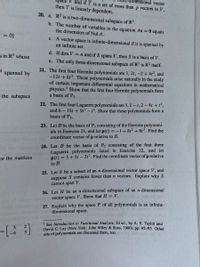
Advanced Engineering Mathematics
10th Edition
ISBN: 9780470458365
Author: Erwin Kreyszig
Publisher: Wiley, John & Sons, Incorporated
expand_more
expand_more
format_list_bulleted
Concept explainers
Question
Number 22 linear algebra

Transcribed Image Text:V and if T is a set of more than p vectors in V,
mensional vector
then T is linearly dependent.
20. a. R2 is a two-dimensional subspace of R'.
b. The number of variables in the equation Ax =0 equals
the dimension of Nul A.
= = %}
c. A vector space is infinite-dimensional if it is spanned by
an infinite set.
d. If dim V =n and if S spans V, then S is a basis of V.
s in R' whose
e. The only three-dimensional subspace of R' is R' itself.
21. The first four Hermite polynomials are 1, 2t, -2+ 4t2, and
-12t + 813. These polynomials arise naturally in the study
of certain important differential equations in mathematical
physics.? Show that the first four Hermite polynomials form
a basis of P3.
2
spanned by
the subspace
22. The first four Laguerre polynomials are 1, 1-1,2-4t +1,
and 6 18t +9t2-t. Show that these polynomials form a
basis of P3.
23. Let B be the basis of P, consisting of the Hermite polynomi-
als in Exercise 21, and let p(t) = -1+8t? + 8t³. Find the
coordinate vector of p relative to B.
24. Let B be the basis of P, consisting of the first three
Laguerre polynomials listed in Exercise 22, and let
p(t) = 5+5t - 2t2. Find the coordinate vector of p relative
For the matrices
to B.
25. Let S be a subset of an n-dimensional vector space V, and
suppose S contains fewer than n vectors. Explain why S
cannot span V.
26. Let H be an n-dimensional subspace of an n-dimensional
vector space V. Show that H =V.
27. Explain why the space P of all polynomials is an infinite-
dimensional space.
2 See Introduction to Functional Analysis, 2d ed., by A. E, Taylor and
David C. Lay (New York: John Wiley & Sons, 1980), pp. 92-93. Other
sets of polynomials are discussed there, too.
3.
Expert Solution
This question has been solved!
Explore an expertly crafted, step-by-step solution for a thorough understanding of key concepts.
This is a popular solution
Trending nowThis is a popular solution!
Step by stepSolved in 3 steps with 3 images

Knowledge Booster
Learn more about
Need a deep-dive on the concept behind this application? Look no further. Learn more about this topic, advanced-math and related others by exploring similar questions and additional content below.Similar questions
Recommended textbooks for you
 Advanced Engineering MathematicsAdvanced MathISBN:9780470458365Author:Erwin KreyszigPublisher:Wiley, John & Sons, Incorporated
Advanced Engineering MathematicsAdvanced MathISBN:9780470458365Author:Erwin KreyszigPublisher:Wiley, John & Sons, Incorporated Numerical Methods for EngineersAdvanced MathISBN:9780073397924Author:Steven C. Chapra Dr., Raymond P. CanalePublisher:McGraw-Hill Education
Numerical Methods for EngineersAdvanced MathISBN:9780073397924Author:Steven C. Chapra Dr., Raymond P. CanalePublisher:McGraw-Hill Education Introductory Mathematics for Engineering Applicat...Advanced MathISBN:9781118141809Author:Nathan KlingbeilPublisher:WILEY
Introductory Mathematics for Engineering Applicat...Advanced MathISBN:9781118141809Author:Nathan KlingbeilPublisher:WILEY Mathematics For Machine TechnologyAdvanced MathISBN:9781337798310Author:Peterson, John.Publisher:Cengage Learning,
Mathematics For Machine TechnologyAdvanced MathISBN:9781337798310Author:Peterson, John.Publisher:Cengage Learning,


Advanced Engineering Mathematics
Advanced Math
ISBN:9780470458365
Author:Erwin Kreyszig
Publisher:Wiley, John & Sons, Incorporated

Numerical Methods for Engineers
Advanced Math
ISBN:9780073397924
Author:Steven C. Chapra Dr., Raymond P. Canale
Publisher:McGraw-Hill Education

Introductory Mathematics for Engineering Applicat...
Advanced Math
ISBN:9781118141809
Author:Nathan Klingbeil
Publisher:WILEY

Mathematics For Machine Technology
Advanced Math
ISBN:9781337798310
Author:Peterson, John.
Publisher:Cengage Learning,

